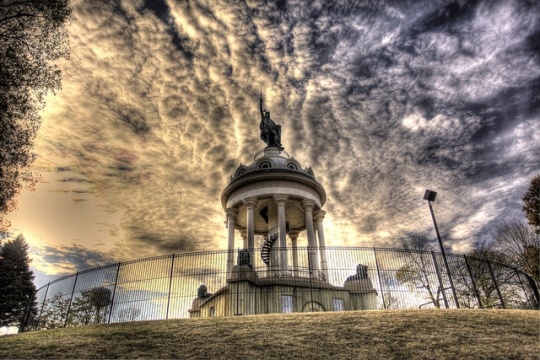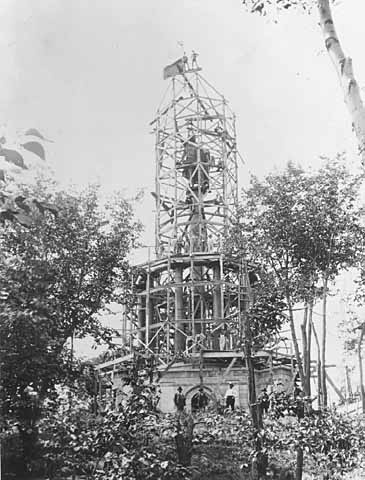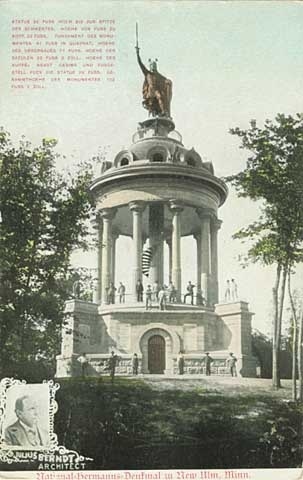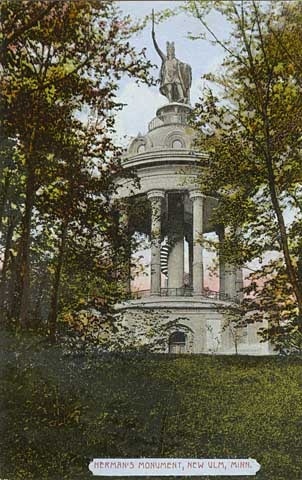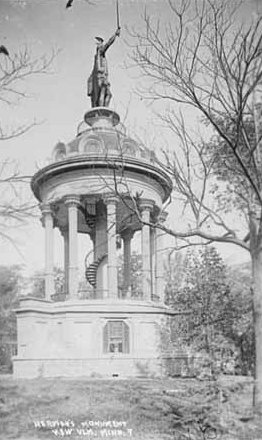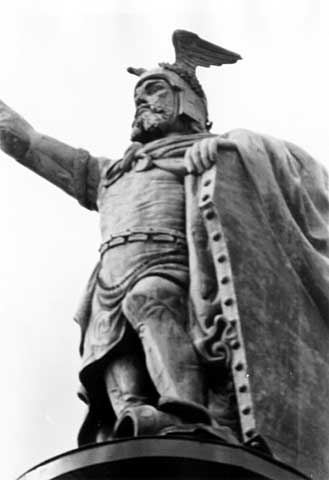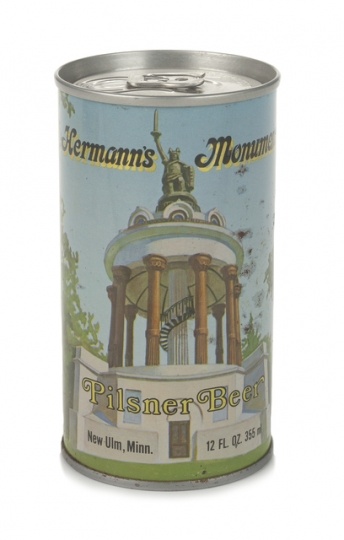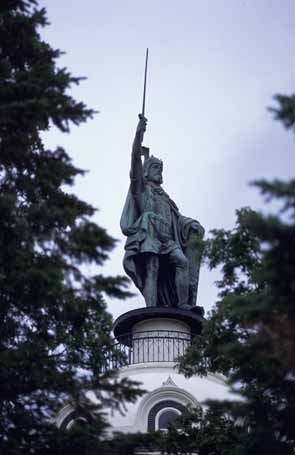“Hermann the German” Monument, New Ulm
Bibliography
34
Hermann Monument files
Manuscript Collection, Brown County Historical Society, New Ulm
Description: The files include newspaper clippings, documents relating to the funding of the monument and its repairs, letters, photographs, and memorabilia from the dedication and other public events at the monument. See especially the Julius Berndt letter regarding the Hermann Monument, 1885, translated by Don Heinrich Tolzmann.
Bordewich, Fergus M. “The Ambush that Changed History.” Smithsonian 36, no. 6 (September 2005): 74–81.
“City To Be Offered Hermann Heights.” New Ulm Journal, February 1, 1929.
Fuchs, Stephan. “History and Heritage of Two Midwestern Towns: A Toponymic-Material Approach.” Journal of Historical Geography 48 (2015): 11–25.
“The German Hermann Monument.” Art Journal (1875–1887), new series, vol. 1 (1875): 123.
“A Hearty Welcome.” New Ulm Review, September 22, 1897.
The Hermann Monument. New Ulm, MN: City of New Ulm Park and Recreation Department, 2007.
Hermann Monument Society.
http://hermannmonument.com/
“Herman Statue is Presented to City By Hermann’s Lodge.” New Ulm Review, February 20, 1919.
Hoisington, Daniel John. A German Town: A History of New Ulm, Minnesota. New Ulm, MN: City of New Ulm, 2004.
Koelpin, Arnold J. The Hermann Monument: A Prairie Tale in the Annals of Americana. New Ulm, MN: City of New Ulm, 1988.
McCallum, Laura. “Ventura Proves His Popularity.” Minnesota Public Radio, September 7, 2001.
http://news.minnesota.publicradio.org/features/200109/07_mccalluml_ventura/
“New Ulm Gets the Monument.” New Ulm Review, July 21, 1886.
Sponholz, Lisa. “New Ulm: Germany in Minnesota.” Undergraduate thesis, University of Minnesota, 1995.
“Taken by Storm.” New Ulm Review, September 29, 1897.
Tolzmann, Don Heinrich. “Appendix II. The Hermann Monument: A National Symbol of the German Heritage.” In New Ulm in Word and Picture: J.H. Strasser’s History of a German-American Settlement (1892), translated and edited by Don Heinrich Tolzmann, and Fredric R. Steinhauser, 49–55. Indianapolis, IN: Max Kade German-American Center, Indiana University—Purdue University at Indianapolis and Indiana German Heritage Society, 1997.
Ubl, Elroy. “Location, Money Problems Plagued Building of Hermann Monument.” New Ulm Review, March 20, 1980.
U.S. Congress, Senate, Committee on Energy and Natural Resources. Hermann Monument and Hermann Heights Park. Report (To Accompany House Congressional Resolution 89). 106th Congress, 2nd Session, October 3, 2000.
Winkler, Martin M. Arminius the Liberator: Myth and Ideology. New York: Oxford University Press, 2016.
Chronology
1840
1875
1881
1885
1888
1889
1897
1907
1929
1973
1999
2000
2002
2004
2005
Bibliography
34
Hermann Monument files
Manuscript Collection, Brown County Historical Society, New Ulm
Description: The files include newspaper clippings, documents relating to the funding of the monument and its repairs, letters, photographs, and memorabilia from the dedication and other public events at the monument. See especially the Julius Berndt letter regarding the Hermann Monument, 1885, translated by Don Heinrich Tolzmann.
Bordewich, Fergus M. “The Ambush that Changed History.” Smithsonian 36, no. 6 (September 2005): 74–81.
“City To Be Offered Hermann Heights.” New Ulm Journal, February 1, 1929.
Fuchs, Stephan. “History and Heritage of Two Midwestern Towns: A Toponymic-Material Approach.” Journal of Historical Geography 48 (2015): 11–25.
“The German Hermann Monument.” Art Journal (1875–1887), new series, vol. 1 (1875): 123.
“A Hearty Welcome.” New Ulm Review, September 22, 1897.
The Hermann Monument. New Ulm, MN: City of New Ulm Park and Recreation Department, 2007.
Hermann Monument Society.
http://hermannmonument.com/
“Herman Statue is Presented to City By Hermann’s Lodge.” New Ulm Review, February 20, 1919.
Hoisington, Daniel John. A German Town: A History of New Ulm, Minnesota. New Ulm, MN: City of New Ulm, 2004.
Koelpin, Arnold J. The Hermann Monument: A Prairie Tale in the Annals of Americana. New Ulm, MN: City of New Ulm, 1988.
McCallum, Laura. “Ventura Proves His Popularity.” Minnesota Public Radio, September 7, 2001.
http://news.minnesota.publicradio.org/features/200109/07_mccalluml_ventura/
“New Ulm Gets the Monument.” New Ulm Review, July 21, 1886.
Sponholz, Lisa. “New Ulm: Germany in Minnesota.” Undergraduate thesis, University of Minnesota, 1995.
“Taken by Storm.” New Ulm Review, September 29, 1897.
Tolzmann, Don Heinrich. “Appendix II. The Hermann Monument: A National Symbol of the German Heritage.” In New Ulm in Word and Picture: J.H. Strasser’s History of a German-American Settlement (1892), translated and edited by Don Heinrich Tolzmann, and Fredric R. Steinhauser, 49–55. Indianapolis, IN: Max Kade German-American Center, Indiana University—Purdue University at Indianapolis and Indiana German Heritage Society, 1997.
Ubl, Elroy. “Location, Money Problems Plagued Building of Hermann Monument.” New Ulm Review, March 20, 1980.
U.S. Congress, Senate, Committee on Energy and Natural Resources. Hermann Monument and Hermann Heights Park. Report (To Accompany House Congressional Resolution 89). 106th Congress, 2nd Session, October 3, 2000.
Winkler, Martin M. Arminius the Liberator: Myth and Ideology. New York: Oxford University Press, 2016.











